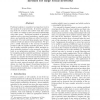721 search results - page 37 / 145 » Graphs with Large Obstacle Numbers |
COMAD
2009
13 years 10 months ago
2009
Positional analysis is considered an important tool in the analysis of social networks. It involves partitioning of the set of actors into subsets such that actors in a subset are...
EON
2007
13 years 10 months ago
2007
We describe an approach to create a synthetic workload for large scale extensional query answering experiments. The workload comprises multiple interrelated domain ontologies, data...
SSDBM
2010
IEEE
13 years 7 months ago
2010
IEEE
Currently, a large amount of data can be best represented as graphs, e.g., social networks, protein interaction networks, etc. The analysis of these networks is an urgent research ...
SIAMCOMP
2010
13 years 7 months ago
2010
Abstract. We study the Edge Disjoint Paths (EDP) problem in undirected graphs: Given a graph G with n nodes and a set T of pairs of terminals, connect as many terminal pairs as pos...
DAM
2010
13 years 9 months ago
2010
An equivalence graph is a disjoint union of cliques, and the equivalence number eq(G) of a graph G is the minimum number of equivalence subgraphs needed to cover the edges of G. W...

